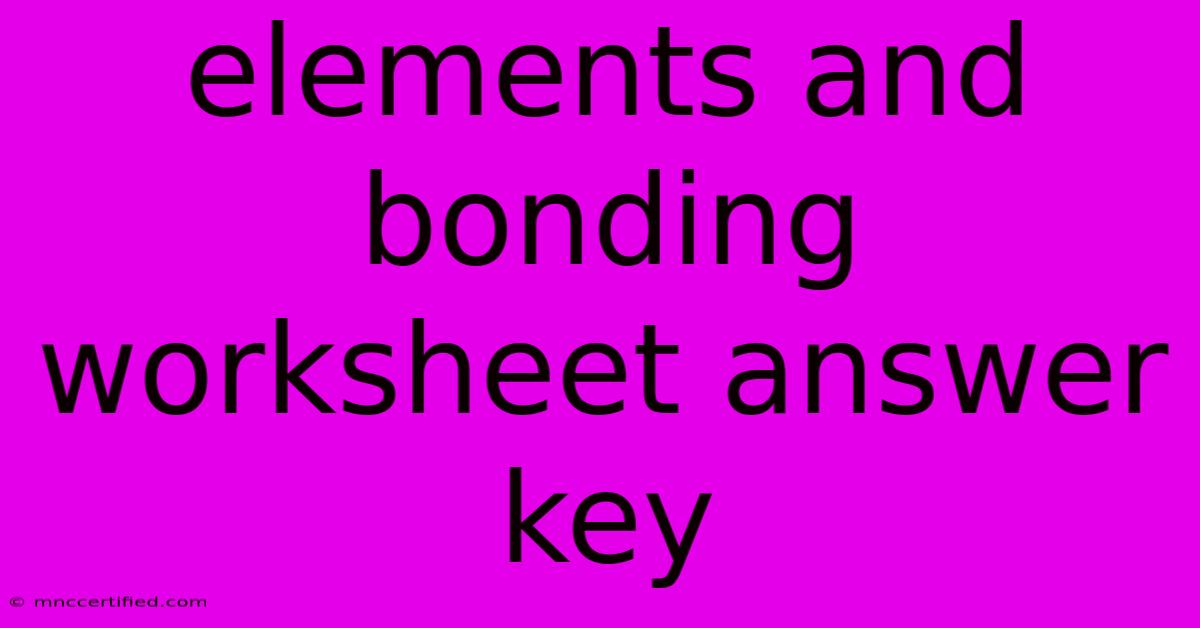Elements And Bonding Worksheet Answer Key

Table of Contents
Unlocking the Secrets of Elements and Bonding: Worksheet Answer Key Explained
Understanding the fundamental building blocks of matter – elements – and the ways they interact – bonding – is crucial in chemistry. It's a stepping stone to comprehending the complex world of molecules and compounds.
This guide provides answers and explanations for a typical "Elements and Bonding" worksheet, helping you solidify your understanding of these concepts.
Section 1: Elements
1. What is an element?
An element is a pure substance that cannot be broken down into simpler substances by ordinary chemical means. Elements are the basic building blocks of all matter.
2. What is the smallest unit of an element?
The smallest unit of an element is an atom.
3. What is the difference between an atom and a molecule?
- Atom: A single, unbonded particle of an element.
- Molecule: Two or more atoms chemically bonded together.
4. List the first 10 elements on the periodic table and their symbols.
- Hydrogen (H)
- Helium (He)
- Lithium (Li)
- Beryllium (Be)
- Boron (B)
- Carbon (C)
- Nitrogen (N)
- Oxygen (O)
- Fluorine (F)
- Neon (Ne)
5. What is the atomic number of an element?
The atomic number represents the number of protons in an atom's nucleus. It uniquely identifies an element.
6. What is the mass number of an element?
The mass number is the sum of protons and neutrons in an atom's nucleus.
7. How do you determine the number of neutrons in an element?
Subtract the atomic number (number of protons) from the mass number to find the number of neutrons.
Section 2: Chemical Bonding
1. What is a chemical bond?
A chemical bond is the attractive force that holds atoms together in a molecule or compound.
2. What are the three main types of chemical bonds?
- Ionic Bonding: The transfer of electrons from one atom to another, resulting in the formation of ions (charged atoms) and an electrostatic attraction.
- Covalent Bonding: The sharing of electrons between atoms.
- Metallic Bonding: A sea of delocalized electrons shared among a lattice of metal atoms.
3. Explain the difference between ionic and covalent bonding.
| Feature | Ionic Bonding | Covalent Bonding |
|---|---|---|
| Electron transfer | Electrons are transferred from one atom to another. | Electrons are shared between atoms. |
| Bond formation | Electrostatic attraction between oppositely charged ions. | Sharing of electrons creates a stable arrangement. |
| Nature of atoms | Typically involves a metal and a non-metal. | Typically involves two non-metals. |
| Examples | Sodium chloride (NaCl), magnesium oxide (MgO) | Water (H₂O), carbon dioxide (CO₂) |
4. Describe the properties of ionic compounds.
- High melting and boiling points due to strong electrostatic forces.
- Solid at room temperature.
- Usually soluble in water.
- Good conductors of electricity when dissolved in water.
5. Describe the properties of covalent compounds.
- Lower melting and boiling points compared to ionic compounds.
- Can be solid, liquid, or gas at room temperature.
- Usually insoluble in water.
- Poor conductors of electricity.
Section 3: Applying Your Knowledge
1. Draw the Lewis dot structure for water (H₂O).
Answer:
..
O
/
H H
2. What type of bond is present in water?
Answer: Covalent bonds.
3. Explain why sodium chloride (NaCl) is an ionic compound.
Answer: Sodium (Na) is a metal, and chlorine (Cl) is a non-metal. Sodium readily loses an electron to become a positively charged ion (Na+), while chlorine gains an electron to become a negatively charged ion (Cl-). The oppositely charged ions attract, forming an ionic bond.
4. Give two examples of covalent compounds.
Answer:
- Water (H₂O)
- Carbon dioxide (CO₂)
Beyond the Worksheet: Deepening Your Understanding
This worksheet is just the beginning! To truly master the concepts of elements and bonding, consider exploring these additional resources:
- Periodic Table: The periodic table is a treasure trove of information about elements. Use it to investigate trends in properties like electronegativity and atomic size.
- Molecular Geometry: Learn about the three-dimensional shapes of molecules and how their geometry impacts their properties.
- Intermolecular Forces: Discover the forces of attraction between molecules and their impact on properties like boiling point and melting point.
Remember, practice makes perfect! Complete more worksheets, study examples, and engage with your textbook or online resources to build a solid understanding of elements and bonding. The journey into the fascinating world of chemistry begins with these fundamental building blocks.

Thank you for visiting our website wich cover about Elements And Bonding Worksheet Answer Key. We hope the information provided has been useful to you. Feel free to contact us if you have any questions or need further assistance. See you next time and dont miss to bookmark.
Featured Posts
-
Bay Area Election Breed Lags In Sf
Nov 07, 2024
-
Is A Medical Pedicure Covered By Insurance
Nov 07, 2024
-
Multi State Workers Compensation Insurance
Nov 07, 2024
-
Trump Talks Elon Musk Space X Programs
Nov 07, 2024
-
How Vance Silenced His Critics With Power
Nov 07, 2024